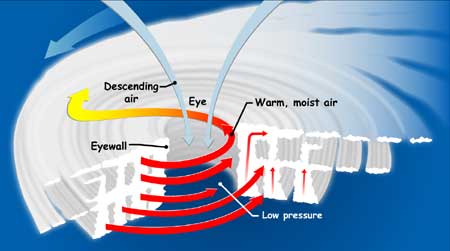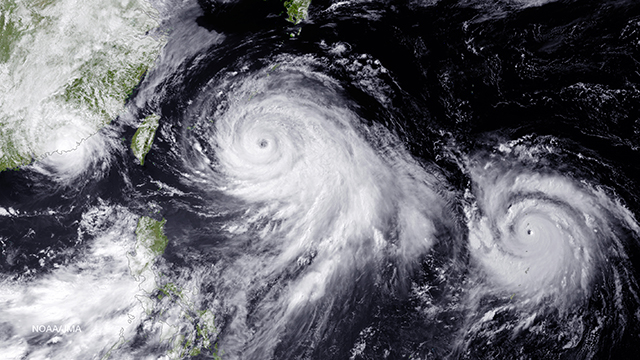Long feared around equatorial regions for their strength and potential for destruction, tropical storms are caused by specific conditions in the ocean and air that come together to form the powerful forces of typhoons, hurricanes, and cyclones. So the answer is: They are all the same phenomenon, but the name varies depending on the location.
How a typhoon is created
The conditions needed for a typhoon include sea temperatures of at least 82 degrees F (27 degrees C) or warmer. When warm dry winds collide with cooler air it creates a twist and makes the beginning of waves. Tropical storm season is considered between June 1-Nov. 30.

NASA illustration
Because the Earth spins faster at the equator than at the Northern and Southern poles — known as the Coriolis effect — areas of different pressure and winds of varying speeds are created.
Water then evaporates from the ocean and is pulled up into the swirl of warm, rising air. The water vapor then cools and condenses into clouds, releasing heat that warms the center of the typhoon. This causes more water vapor to be pulled up from the ocean creating a continuing cycle.
DID YOU KNOW?
* “Typhoon” is one of the rare English loanwords that originates from Chinese: 台风 or “taifeng” meaning “big wind”.
* In the Atlantic and northern Pacific regions tropical storms are called “hurricanes”, after the Caribbean god of evil, Hurican.
* The Carib god Hurican comes from the Mayan god Hurakan, one of their creator gods, who blew his breath across the chaotic water and brought forth dry land, and later destroyed the men of wood with a great storm and flood.
So when is it a typhoon, hurricane, or cyclone?
What you call a tropical storm depends on where it occurs.
If you’re in the North Atlantic Ocean, the Northeast Pacific Ocean east of the international dateline, or the South Pacific Ocean it’s a hurricane.
If you are in the Northwest Pacific Ocean west of the international dateline, it’s a typhoon.
If you are in the Southwest Pacific Ocean west or Southeast Indian Ocean, it’s a severe tropical cyclone or Category 3 cyclone.
In the North Indian Ocean it is a very severe cyclonic storm.
In the North Indian Ocean it’s a tropical cyclone.

NOAA illustration: Tropical storms forming between 5 and 30 degrees North latitude typically move toward the west. Sometimes the winds in the middle and upper levels of the atmosphere change and steer the cyclone toward the north and northwest. When tropical cyclones reach latitudes near 30 degrees North, they often move northeast. The different colors indicate the direction the storms are likely to head once formation begins.
DID YOU KNOW?
Storms that form north of the equator spin counterclockwise. Storms south of the equator spin clockwise. This difference is because of Earth’s rotation on its axis. The size of a typhoon is classified by the radius of the area in which the wind speed exceeds 15 m/s. The intensity and size represents different aspects of a typhoon. That is, we could have a strong but not large typhoon, and also a large but not strong typhoon.
Levels of intensity
The minimum winds for a typhoon is 74mph (119 km). When a storm hits 150 mph (241 km) it’s considered a “supertyphoon.” Other speeds also affect what you call a tropical storm.
A tropical cyclone with maximum sustained winds of 38 mph (33 knots) or less is a tropical depression.
A tropical cyclone with maximum sustained winds of 39 to 73 mph (34 to 63 knots) is a tropical storm.
A tropical cyclone with maximum sustained winds of 74 mph (119 km per hour or 64 knots) or higher is a hurricane, typhoon, or cyclone.
A tropical cyclone with maximum sustained winds of 111 mph (96 knots) or higher, corresponding to a Category 3, 4 or 5 on the Saffir-Simpson Hurricane Wind Scale (based on a scale of 1-5) is a major or “intense” Hurricane.
How a typhoon is named
Though storms used to be named arbitrarily with numbers or location, they are now named according to a list developed by the World Meterological Society in Switzerland.
Many countries in Asia contribute to the name list for storms in the Western North Pacific and South China Sea. Typhoon Chan-hom which is due to hit ground in East China today is named after a species of tree by the Lao People’s Democratic Republic.
Though the list re-circulates every several years, if a storm causes a large amount of devastation, the name is retired from the list. Examples of such notorious storms are Katrina (USA, 2005), Mitch (Honduras, 1998) and Tracy (Darwin, 1974).

Giant waves crash into the coastline next to National Taiwan Ocean University (R) in Keelung as Typhoon Chan-hom brings rain to northern Taiwan on July 10, 2015. Taiwan was bracing for fierce winds and torrential rains on July 10 as Typhoon Chan-hom gained momentum and the island’s stock market, schools and offices closed in preparation for the storm. AFP PHOTO / Sam Yeh
Sources: NOAA, NASA, AGORA/National Institute of Informatics, World Meteorological Association.
 CGTN America
CGTN America
 This NOAA photo obtained July 10, 2015, taken by JMA MTSAT at 0530Z on July 9, 2015 shows two typhoons in the Philippine Sea and a tropical storm near the China coast near Hong Kong and Macau which have the region on alert. AFP PHOTO/NOAA/HANDOUT
This NOAA photo obtained July 10, 2015, taken by JMA MTSAT at 0530Z on July 9, 2015 shows two typhoons in the Philippine Sea and a tropical storm near the China coast near Hong Kong and Macau which have the region on alert. AFP PHOTO/NOAA/HANDOUT
